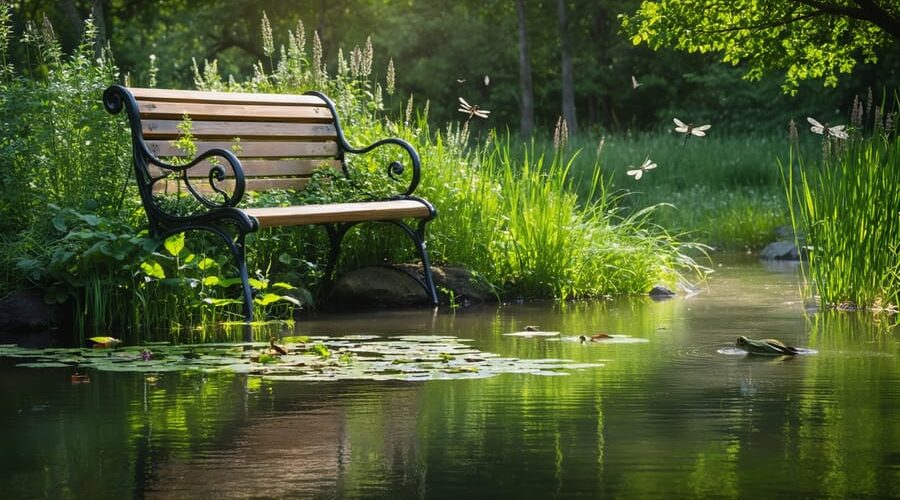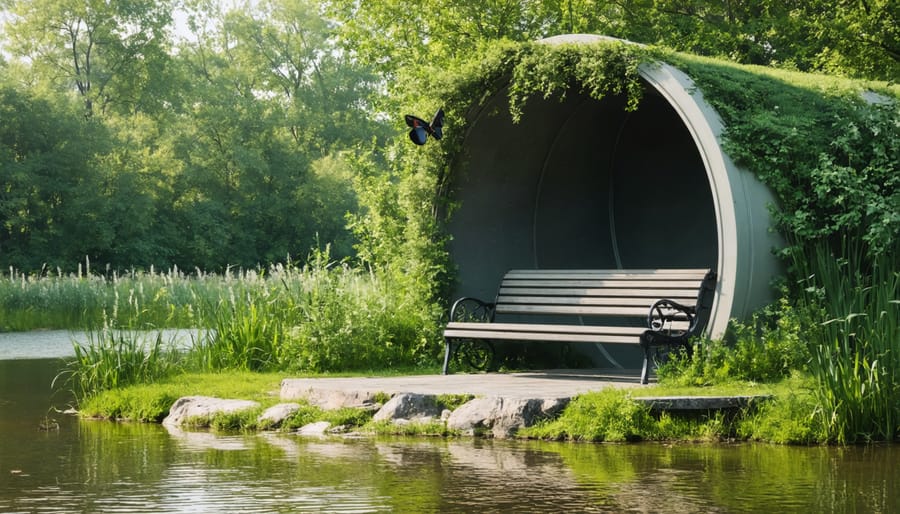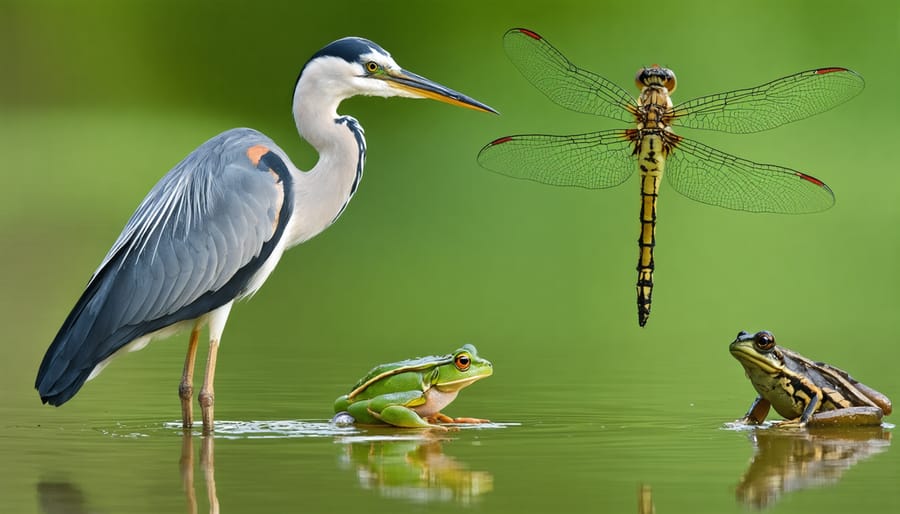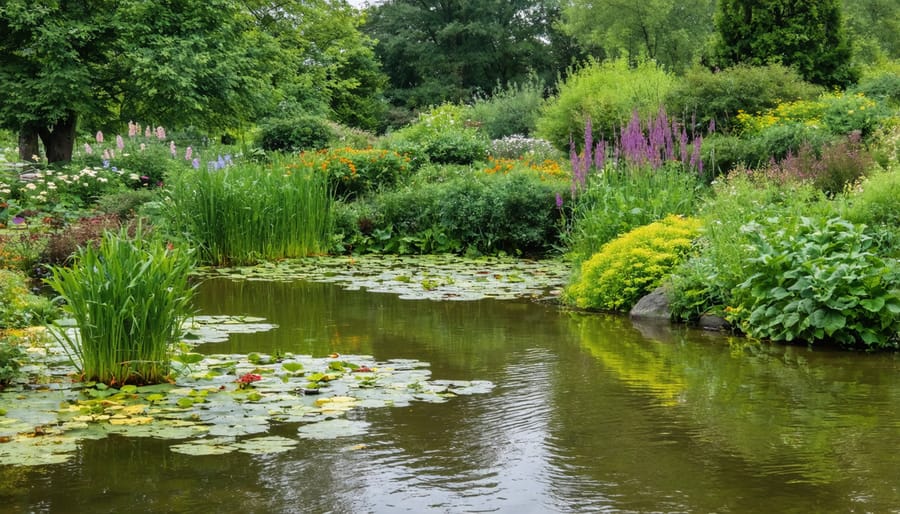
Transform Your Pond into a Wildlife Haven: Simple Tips for Magical Nature Moments
Discover the hidden world of wildlife right in your backyard by creating deliberate observation spaces near water sources, natural cover, and feeding areas. Position yourself downwind, remain absolutely still for at least 15 minutes, and let nature’s drama unfold before your eyes. While enjoying your pond space, maintain a detailed journal of wildlife sightings, including species, behaviors, and seasonal patterns to develop a deeper understanding of your local ecosystem. Install wildlife-friendly features like shallow water zones, native plants, and natural perches to attract a diverse range of creatures, from darting dragonflies to cautious songbirds. Early morning and dusk offer prime viewing opportunities when animals are most active, making these golden hours perfect for quiet observation with binoculars or a camera ready to capture fleeting moments. Transform your outdoor space into a vibrant wildlife sanctuary where every day brings new discoveries and unexpected encounters with nature’s most fascinating residents.
Creating the Perfect Wildlife Viewing Station
Best Viewing Spots and Seating
Creating a peaceful pond environment starts with choosing the right observation spots. Set up seating at least 10-15 feet away from the water’s edge to avoid startling wildlife. Natural materials like wooden benches or weathered rocks blend seamlessly into the landscape and won’t disturb the pond’s inhabitants.
Consider building a simple viewing blind using bamboo screens or natural vegetation. This helps conceal your presence while providing a comfortable spot to observe. Position your seating to face away from the sun to prevent glare on the water’s surface and improve visibility.
Create multiple viewing locations around your pond to observe different areas and catch various wildlife activities throughout the day. Morning and evening are typically the most active times, so ensure your chosen spots work well in different lighting conditions.
Add some strategically placed stepping stones to access your viewing spots quietly. Remember to maintain a clear path that won’t rustle leaves or create noise when approaching. The key is to become part of the environment rather than an intrusion into it.

Camouflage and Concealment
To effectively observe wildlife around your pond, it’s essential to blend seamlessly into the environment. Creating tranquil observation spots behind natural screens of plants or existing landscape features will help you remain hidden while watching.
Wear earth-toned clothing that matches your surroundings – think browns, greens, and grays. Avoid bright colors or patterns that might startle wildlife. Moving slowly and deliberately is just as important as what you wear; sudden movements will send creatures scurrying away.
Consider building a simple blind or screen using natural materials like bamboo or reed fencing. Position it near popular wildlife gathering spots, such as shallow areas or feeding zones. You can also use existing structures like garden sheds or pergolas as observation points.
Stay downwind from the areas you’re observing, as many animals have a keen sense of smell. Keep noise to a minimum – even whispers can spook sensitive wildlife. For the best viewing opportunities, arrive at your observation spot early and remain patient. Wildlife will eventually resume their natural behaviors once they’ve grown accustomed to your presence.

Common Pond Visitors and When to See Them
Birds and Waterfowl
Ponds naturally attract a diverse array of birds and waterfowl, turning your backyard into a bustling wildlife sanctuary. Common visitors include mallard ducks, which often arrive in pairs during spring and fall migrations. These adaptable birds are easily recognized by the male’s distinctive green head and the female’s mottled brown plumage.
Great blue herons are particularly fascinating to observe, standing motionless at the water’s edge before striking with lightning speed to catch fish. While beautiful, these large birds can be a concern for pond owners with small fish, so maintaining deeper areas in your pond helps protect your finned friends.
Song birds frequently visit ponds for drinking and bathing, especially during hot summer months. American robins, cardinals, and chickadees are regular visitors, creating delightful splashing displays in shallow areas. To encourage more bird activity, consider adding a gentle slope or beach area where birds can easily access the water.
Watch for seasonal patterns in bird behavior. During early morning and late afternoon hours, birds are typically most active around ponds. Spring brings nesting pairs, while fall sees migrating flocks stopping for rest. Creating natural perches with partially submerged logs or strategically placed rocks gives birds safe spots to land and observe their surroundings.
Remember to maintain a respectful distance when watching birds, as they’re more likely to display natural behaviors when they feel secure. A pair of binoculars and a comfortable viewing spot will enhance your bird-watching experience while minimizing disturbance to these fascinating creatures.
Amphibians and Reptiles
Amphibians and reptiles are some of the most fascinating creatures you can observe around your pond. In spring and summer, you might spot frogs perched on lily pads or hear their distinctive croaking at dusk. Common frogs and toads are particularly active during breeding season, when they return to water to lay their spawn.
Keep an eye out for newts, which can often be seen swimming gracefully through the water or hunting for small insects. The best time to spot these elusive creatures is during early morning or evening hours when they’re most active. You might catch glimpses of their distinctive orange bellies as they dart between plants.
For successful amphibian watching, maintain some shallow areas in your pond and plenty of surrounding vegetation for shelter. Avoid using chemicals in your garden, as amphibians are particularly sensitive to pollutants. Creating a small log pile or rock garden near your pond provides perfect hiding spots for these creatures.
Grass snakes might also visit your pond to hunt, especially during warmer months. While they’re shy creatures, you might spot them swimming across the water or basking in sunny spots nearby. Remember to observe these animals from a distance to avoid disturbing them in their natural habitat.
Insects and Other Small Visitors
A pond environment attracts a fascinating variety of small winged visitors that add color and life to your garden. Dragonflies and damselflies are particularly welcome guests, as they help control mosquito populations while dazzling observers with their acrobatic flights and iridescent wings. You’ll often spot them perched on tall plants near the water’s edge or patrolling their territory above the pond surface.
Butterflies are drawn to the moisture and mineral content of pond edges, especially on warm days. Creating a butterfly-friendly environment with native flowering plants around your pond will encourage these beautiful insects to visit regularly. Look for species like swallowtails, monarchs, and painted ladies, which often stop by for a drink.
Beneficial insects like ladybugs, praying mantises, and honey bees also frequent pond areas, contributing to the overall ecosystem health. These tiny helpers keep pest populations in check and assist with pollination. To encourage more insect visitors, avoid using pesticides near your pond and maintain diverse plant life around the water’s edge. Consider adding flat stones near the pond where butterflies and other insects can rest and warm themselves in the sun.
Essential Wildlife Watching Tools
Basic Equipment
To get started with wildlife observation, you’ll need some basic but essential equipment. A good pair of binoculars is your most important tool – look for ones with 8×42 or 10×42 magnification for the best balance between power and field of view. Make sure they’re waterproof, as you’ll often be near water or out in varying weather conditions.
A camera is another valuable piece of equipment. While smartphones can capture decent photos, a camera with a zoom lens will help you document wildlife without disturbing them. Consider a bridge camera or entry-level DSLR with a telephoto lens if you’re serious about wildlife photography.
Don’t forget to keep a nature journal! A weatherproof notebook and pen are perfect for recording your observations, including dates, times, species spotted, and behavioral notes. This helps you track patterns and seasonal changes in wildlife activity. Some observers prefer digital note-taking apps, but there’s something special about sketching and writing observations by hand.
A field guide specific to your local wildlife can help you identify different species. Consider keeping it in a waterproof bag along with your other equipment to protect it from splashes and unexpected rain.
Photography Tips
Capturing wildlife moments around your pond doesn’t require professional equipment. Start with your smartphone using the burst mode feature – simply hold down the shutter button to take multiple shots quickly, increasing your chances of getting that perfect moment. For better stability, rest your arms on a solid surface or use a small tripod.
If you’re using a digital camera, set it to a faster shutter speed (at least 1/500th of a second) to freeze motion. Early morning and late afternoon provide the best natural lighting, creating warm, beautiful photos. Position yourself with the sun behind you when possible to illuminate your subject.
Zoom lenses are helpful for capturing close-ups without disturbing wildlife, but remember to stay still and quiet. Consider setting up a simple blind using natural materials or a pop-up tent to remain hidden. Keep your camera ready and pre-focused on spots where animals frequently visit, like popular perches or feeding areas.
For the best results, take multiple photos of each subject and be patient. Wildlife photography is often about waiting for the right moment, so bring a comfortable chair and enjoy the peaceful observation time.
Making Your Pond More Wildlife-Friendly
Plant Selection and Placement
Selecting the right plants is crucial for creating inviting outdoor spaces that attract and shelter wildlife. Native plants are your best choice, as they’ve naturally evolved alongside local wildlife and require less maintenance.
Around your pond, consider adding plants at different heights to create diverse habitats. Tall grasses like sedges and rushes provide excellent cover for small creatures, while flowering plants such as purple coneflowers and black-eyed susans attract butterflies and bees. Don’t forget to include some berry-producing shrubs like elderberry or serviceberry – these are fantastic food sources for birds.
Layer your plantings with ground cover, mid-height plants, and taller species. This creates a natural progression that wildlife can use for protection and navigation. Near the water’s edge, plant moisture-loving species like marsh marigolds and iris, which provide perfect spots for frogs and dragonflies to rest.
Consider the seasons when planning your plant selection. Spring-blooming plants like columbine attract early pollinators, while late-blooming asters provide essential food for migrating butterflies. Leave seed heads standing through winter – they’re valuable food sources for birds during scarce times.
Remember to include some dense evergreen shrubs for year-round shelter. These become especially important during harsh weather and provide safe nesting sites for birds. Position these plants away from primary viewing areas so wildlife feels secure while remaining visible enough for your enjoyment.
Space your plants appropriately to allow for growth while maintaining clear sight lines to your pond. This balance ensures wildlife feels protected while you can still observe their natural behaviors.

Creating Safe Zones
Creating safe zones for wildlife around your pond is essential for successful observation and protecting your visiting creatures. Start by establishing different habitat layers – underwater, at the water’s edge, and in the surrounding area. Include plenty of dense vegetation and natural hiding spots where animals can quickly retreat when they feel threatened.
Around the pond’s edge, maintain areas of long grass and native plants that provide cover for small mammals and amphibians. Add partially submerged logs or rocks that create basking spots for turtles and frogs while offering quick escape routes into the water. Floating plants like water lilies not only look beautiful but provide essential shelter for fish and aquatic insects.
Consider creating designated quiet zones where human activity is minimized. These areas should be at least 10-15 feet away from high-traffic areas of your yard. Install natural barriers like shrubs or ornamental grasses to create boundaries between human spaces and wildlife zones.
Avoid using chemicals and pesticides near your wildlife areas, as these can harm both animals and their food sources. Instead, embrace natural pest control methods and native plants that support local ecosystems. Install motion-sensitive lighting rather than constant bright lights, which can disturb nocturnal wildlife.
If you have pets, consider setting up physical barriers or designated viewing areas that keep them separated from wildlife zones. This separation helps wild animals feel secure enough to visit regularly. Remember to maintain these safe zones throughout the year, as many creatures rely on consistent shelter and protection, especially during breeding seasons and harsh weather conditions.
Observing wildlife around your pond can be one of the most rewarding aspects of having a water feature in your garden. From the delicate dance of dragonflies skimming across the water’s surface to the patient stalking of herons at dawn, each moment spent watching nature unfold brings new discoveries and deeper connections to the natural world.
We’ve explored various techniques and tools that can enhance your wildlife watching experience, from selecting the right binoculars to creating hidden viewing spots. Remember that successful wildlife observation requires patience, quiet movement, and respect for the creatures you’re watching. The more time you spend observing, the better you’ll become at spotting different species and understanding their behaviors.
Creating a wildlife-friendly environment is crucial for attracting diverse species. By maintaining healthy water quality, providing appropriate plants for shelter and food, and ensuring your pond offers different depths and zones, you’ll create an inviting habitat that wildlife will naturally gravitate toward.
Start your wildlife watching journey today – even if you only have a few minutes to spare. Keep a journal of your observations, take photographs when possible, and share your experiences with fellow nature enthusiasts. Every season brings new visitors and behaviors to observe, making pond wildlife watching an ever-changing adventure that will enrich your life and deepen your appreciation for the natural world around you.
Remember, the best wildlife encounters often happen when you least expect them, so always keep your eyes open and your camera ready. Happy watching!
